Cub cadet GTX 1054, GT 1054 User Manual
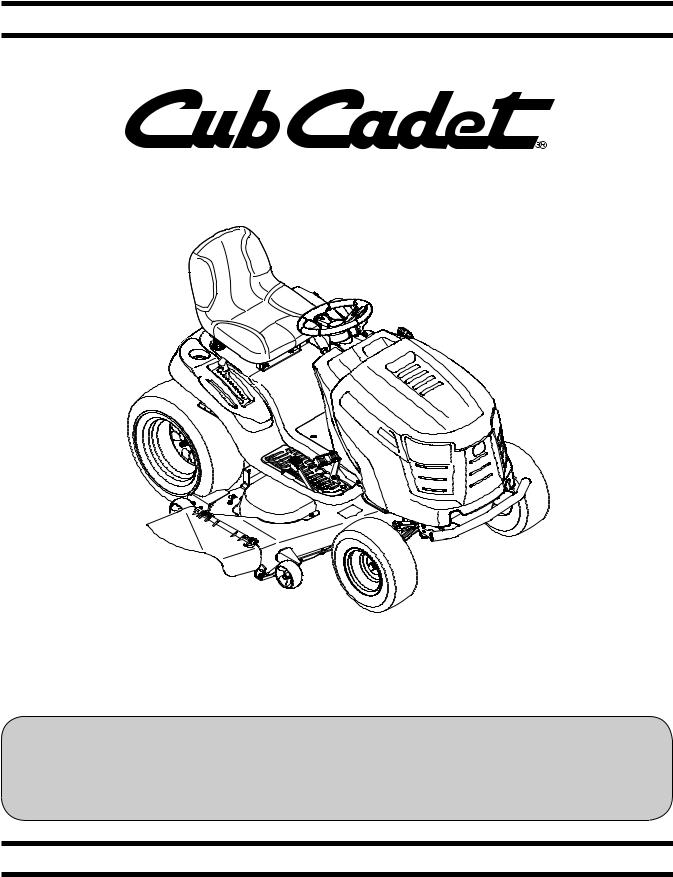
Safe Operation Practices • Set-Up • Operation • Maintenance • Service • Troubleshooting • Warranty
Operator’s Manual
Hydrostatic Garden Tractor — GT 1054, GTX 1054
 WARNING
WARNING
READ AND FOLLOW ALL SAFETY RULES AND INSTRUCTIONS IN THIS MANUAL
BEFORE ATTEMPTING TO OPERATE THIS MACHINE.
FAILURE TO COMPLY WITH THESE INSTRUCTIONS MAY RESULT IN PERSONAL INJURY.
CUB CADET LLC, P.O. BOX 361131 CLEVELAND, OHIO 44136-0019
Printed In USA |
Form No. 769-08379 |
|
(December 18, 2012) |

To The Owner
Thank You
Thank you for purchasing a Cub Cadet Garden Tractor. It was carefully engineered to provide excellent performance when properly operated and maintained.
Please read this entire manual prior to operating the equipment. It instructs you how to safely and easily set up, operate and maintain your machine. Please be sure that you, and any other persons who will operate the machine, carefully follow the recommended safety practices at all times. Failure to do so could result in personal injury or property damage.
All information in this manual is relative to the most recent product information available at the time of printing. Review this manual frequently to familiarize yourself with the machine, its features and operation. Please be aware that this Operator’s
Manual may cover a range of product specifications for various models. Characteristics and features discussed and/or illustrated in this manual may not be applicable to all models. We reserve the right to change product specifications, designs and equipment without notice and without incurring obligation.
1
If applicable, the power testing information used to establish the power rating of the engine equipped on this machine can be found at www.opei.org or the engine manufacturer’s web site.
If you have any problems or questions concerning the machine, phone your local Cub Cadet dealer or contact us directly. Cub
Cadet’s Customer Support telephone numbers, website address and mailing address can be found on this page. We want to ensure your complete satisfaction at all times.
Throughout this manual, all references to right and left side of the machine are observed from the operating position
The engine manufacturer is responsible for all engine-related issues with regards to performance, power-rating, specifications, warranty and service. Please refer to the engine manufacturer’s Owner’s/Operator’s Manual, packed separately with your machine, for more information.
Table of Contents
Safe Operation Practices......................................... |
3 |
Service..................................................................... |
25 |
Assembly & Set-Up................................................... |
9 |
Troubleshooting..................................................... |
30 |
Controls.................................................................... |
12 |
Replacement Parts.................................................. |
31 |
Operation................................................................ |
15 |
Attachments & Accessories................................... |
33 |
Maintenance & Adjustment.................................. |
19 |
Warranty................................................... |
Back Cover |
Record Product Information |
Model Number |
|
|
|
|
|
|
|
|
|||||||||
Before setting up and operating your new equipment, please |
|
|
|
|
|
|
|
|
|
|
|
|
|
|
|
|
|
|
|
|
|
|
|
|
|
|
|
|
|
|
|
|
|
|
|
||
locate the model plate on the equipment and record the |
|
|
|
|
|
|
|
|
|
|
|
|
|
|
|
|
|
|
information in the provided area to the right. You can locate the |
|
|
|
|
|
|
|
|
|
|
|
|
|
|
|
|
|
|
|
|
|
|
|
|
|
|
|
|
|
|
|
|
|
|
|
||
model plate by looking beneath the seat. This information will |
Serial Number |
|
|
|
|
|
|
|
|
|||||||||
be necessary, should you seek technical support via our web site, |
|
|
|
|
|
|
|
|
||||||||||
Customer Support Department, or with a local authorized service |
|
|
|
|
|
|
|
|
|
|
|
|
|
|
|
|
|
|
|
|
|
|
|
|
|
|
|
|
|
|
|
|
|
|
|
||
dealer. |
|
|
|
|
|
|
|
|
|
|
|
|
|
|
|
|
|
|
|
|
|
|
|
|
|
|
|
|
|
|
|
|
|
|
|
||
|
|
|
|
|
|
|
|
|
|
|
|
|
|
|
|
|
|
|
|
|
|
|
|
|
|
|
|
|
|
|
|
|
|
|
|
|
|
Product Registration and Customer Support
Please register your product on our website, www.cubcadet.com.
If you have difficulty assembling this product or have any questions regarding the controls, operation, or maintenance of this machine, you can seek help from the experts. Choose from the options below:
◊Visit us on the web at www.cubcadet.com
See How-to Maintenance and Parts Installation Videos at www.cubcadet.com/tutorials
◊Call a Customer Support Representative at (800) 965-4CUB
◊Locate your nearest Cub Cadet Dealer at (877) 282-8684
◊Write us at Cub Cadet LLC • P.O. Box 361131 • Cleveland, OH • 44136-0019
2
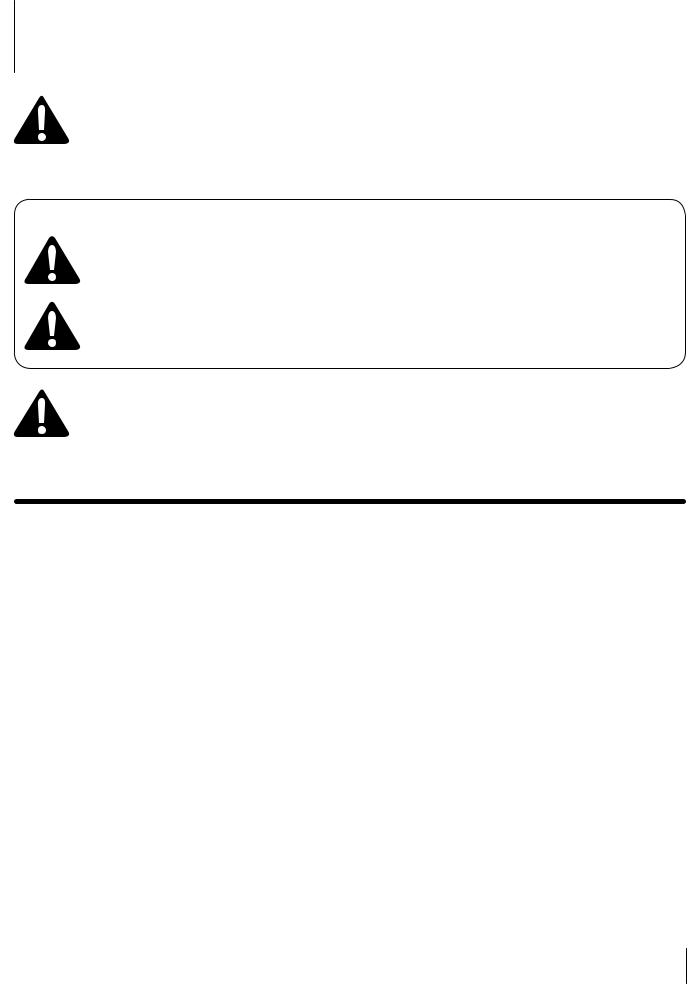
Important Safe Operation Practices |
2 |
|
|
|
|
WARNING! This symbol points out important safety instructions which, if not followed, could endanger the personal safety and/or property of yourself and others. Read and follow all instructions in this manual before attempting to operate this machine. Failure to comply with these instructions may result in personal injury.
When you see this symbol. HEED ITS WARNING!
CALIFORNIA PROPOSITION 65
WARNING! Engine Exhaust, some of its constituents, and certain vehicle components contain or emit chemicals known to State of California to cause cancer and birth defects or other reproductive harm.
WARNING! Battery posts, terminals, and related accessories contain lead and lead compounds, chemicals known to the State of California to cause cancer and reproductive harm. Wash hands after handling
DANGER! This machine was built to be operated according to the safe operation practices in this manual. As with any type of power equipment, carelessness or error on the part of the operator can result in serious injury. This machine is capable of amputating hands and feet and throwing objects. Failure to observe the following safety instructions could result in serious injury or death.
General Operation
1.Read, understand, and follow all instructions on the machine and in the manual(s) before attempting to assemble and operate. Keep this manual in a safe place for future and regular reference and for ordering replacement parts.
2.Be familiar with all controls and their proper operation. Know how to stop the machine and disengage them quickly.
3.Never allow children under 14 years of age to operate this machine. Children 14 and over should read and understand the instructions and safe operation practices in this manual and on the machine and should be trained and supervised by an adult.
4.Never allow adults to operate this machine without proper instruction.
5.To help avoid blade contact or a thrown object injury, keep bystanders, helpers, children and pets at least 75 feet from the machine while it is in operation. Stop machine if anyone enters the area.
6.Thoroughly inspect the area where the equipment is to be used. Remove all stones, sticks, wire, bones, toys, and other foreign objects which could be picked up and thrown by the blade(s). Thrown objects can cause serious personal injury.
7.Plan your mowing pattern to avoid discharge of material toward roads, sidewalks, bystanders and the like. Also, avoid discharging material against a wall or obstruction which may cause discharged material to ricochet back toward the operator.
8.Always wear safety glasses or safety goggles during operation and while performing an adjustment or repair to protect your eyes. Thrown objects which ricochet can cause serious injury to the eyes.
9.Wear sturdy, rough-soled work shoes and close-fitting slacks and shirts. Loose fitting clothes and jewelry can be caught in movable parts. Never operate this machine in bare feet or sandals.
10.Be aware of the mower and attachment discharge direction and do not point it at anyone. Do not operate the mower without the discharge cover or entire grass catcher in its proper place.
11.Do not put hands or feet near rotating parts or under the cutting deck. Contact with the blade(s) can amputate hands and feet.
3
12.A missing or damaged discharge cover can cause blade contact or thrown object injuries.
13.Stop the blade(s) when crossing gravel drives, walks, or roads and while not cutting grass.
14.Watch for traffic when operating near or crossing roadways. This machine is not intended for use on any public roadway.
15.Do not operate the machine while under the influence of alcohol or drugs.
16.Mow only in daylight or good artificial light.
17.Never carry passengers.
18.Disengage blade(s) before shifting into reverse. Back up slowly. Always look down and behind before and while backing to avoid a back-over accident.
19.Slow down before turning. Operate the machine smoothly.
Avoid erratic operation and excessive speed.
20.Disengage blade(s), set parking brake, stop engine and wait until the blade(s) come to a complete stop before removing grass catcher, emptying grass, unclogging chute, removing any grass or debris, or making any adjustments.
21.Never leave a running machine unattended. Always turn off blade(s), place transmission in neutral, set parking brake, stop engine and remove key before dismounting.
22.Use extra care when loading or unloading the machine into a trailer or truck. This machine should not be driven up or down ramp(s), because the machine could tip over, causing serious personal injury. The machine must be pushed manually on ramp(s) to load or unload properly.
23.Muffler and engine become hot and can cause a burn. Do not touch.
24.Check overhead clearances carefully before driving under low hanging tree branches, wires, door openings etc., where the operator may be struck or pulled from the machine, which could result in serious injury.
25.Disengage all attachment clutches, depress the brake pedal completely and shift into neutral before attempting to start engine.
26.Your machine is designed to cut normal residential grass of a height no more than 10”. Do not attempt to mow through unusually tall, dry grass (e.g., pasture) or piles of dry leaves. Dry grass or leaves may contact the engine exhaust and/ or build up on the mower deck presenting a potential fire hazard.
27.Use only accessories and attachments approved for this machine by the machine manufacturer. Read, understand and follow all instructions provided with the approved accessory or attachment.
28.Data indicates that operators, age 60 years and above, are involved in a large percentage of riding mower-related injuries. These operators should evaluate their ability
to operate the riding mower safely enough to protect themselves and others from serious injury.
29.If situations occur which are not covered in this manual, use care and good judgment. Contact your customer service representative for assistance.
Slope Operation
Slopes are a major factor related to loss of control and tip-over accidents which can result in severe injury or death. All slopes require extra caution. If you cannot back up the slope or if you feel uneasy on it, do not mow it.
For your safety, use the slope gauge included as part of this manual to measure slopes before operating this machine on a sloped or hilly area. If the slope is greater than 15 degrees as
shown on the slope gauge, do not operate this machine on that area or serious injury could result.
Do:
1.Mow up and down slopes, not across. Exercise extreme caution when changing direction on slopes.
2.Watch for holes, ruts, bumps, rocks, or other hidden objects. Uneven terrain could overturn the machine. Tall grass can hide obstacles.
3.Use slow speed. Choose a low enough speed setting so that you will not have to stop or shift while on the slope. Tires may lose traction on slopes even though the brakes are functioning properly. Always keep machine in gear when going down slopes to take advantage of engine braking action.
4.Follow the manufacturer’s recommendations for wheel weights or counterweights to improve stability.
5.Use extra care with grass catchers or other attachments. These can change the stability of the machine.
6.Keep all movement on the slopes slow and gradual. Do not make sudden changes in speed or direction. Rapid engagement or braking could cause the front of the machine to lift and rapidly flip over backwards which could cause serious injury.
7.Avoid starting or stopping on a slope. If tires lose traction, disengage the blade(s) and proceed slowly straight down the slope.
Do Not:
1.Do not turn on slopes unless necessary; then, turn slowly and gradually downhill, if possible.
2.Do not mow near drop-offs, ditches or embankments. The mower could suddenly turn over if a wheel is over the edge of a cliff, ditch, or if an edge caves in.
3.Do not try to stabilize the machine by putting your foot on the ground.
4.Do not use a grass catcher on steep slopes.
5.Do not mow on wet grass. Reduced traction could cause sliding.
6.Do not shift to neutral and coast downhill. Over-speeding may cause the operator to lose control of the machine resulting in serious injury or death.
7.Do not tow heavy pull behind attachments (e.g. loaded dump cart, lawn roller, etc.) on slopes greater than 5 degrees. When going down hill, the extra weight tends to push the tractor and may cause you to loose control
(e.g. tractor may speed up, braking and steering ability are reduced, attachment may jack-knife and cause tractor to overturn).
4 |
|
Section 2 — Important Safe Operation Practices |
|
||
|
|
|
Children
1.Tragic accidents can occur if the operator is not alert to the presence of children. Children are often attracted to the machine and the mowing activity. They do not understand the dangers. Never assume that children will remain where you last saw them.
a.Keep children out of the mowing area and in watchful care of a responsible adult other than the operator.
b.Be alert and turn machine off if a child enters the area.
c.Before and while backing, look behind and down for small children.
d.Never carry children, even with the blade(s) shut off. They may fall off and be seriously injured or interfere with safe machine operation.
e.Use extreme care when approaching blind corners, doorways, shrubs, trees or other objects that may block your vision of a child who may run into the path of the machine.
f.To avoid back-over accidents, always disengage the cutting blade(s) before shifting into Reverse. If equipped, the “Reverse Caution Mode” should not be used when children or others are around.
g.Keep children away from hot or running engines. They can suffer burns from a hot muffler.
h.Remove key when machine is unattended to prevent unauthorized operation.
2.Never allow children under 14 years of age to operate this machine. Children 14 and over should read and understand the instructions and safe operation practices in this manual and on the machine and should be trained and supervised by an adult.
Towing
1.Tow only with a machine that has a hitch designed for towing. Do not attach towed equipment except at the hitch point.
2.Follow the manufacturers recommendation for weight limits for towed equipment and towing on slopes.
3.Never allow children or others in or on towed equipment.
4.On slopes, the weight of the towed equipment may cause loss of traction and loss of control.
5.Always use extra caution when towing with a machine capable of making tight turns (e.g. “zero-turn” ride-on mower). Make wide turns to avoid jack-knifing.
6.Travel slowly and allow extra distance to stop.
7.Do not shift to neutral and coast downhill.
Service
Safe Handling of Gasoline:
1.To avoid personal injury or property damage use extreme care in handling gasoline. Gasoline is extremely flammable and the vapors are explosive. Serious personal injury can occur when gasoline is spilled on yourself or your clothes which can ignite. Wash your skin and change clothes immediately.
a.Use only an approved gasoline container.
b.Never fill containers inside a vehicle or on a truck or trailer bed with a plastic liner. Always place containers on the ground away from your vehicle before filling.
c.When practical, remove gas-powered equipment from the truck or trailer and refuel it on the ground. If this is not possible, then refuel such equipment on a trailer with a portable container, rather than from a gasoline dispenser nozzle.
d.Keep the nozzle in contact with the rim of the fuel tank or container opening at all times until fueling is complete. Do not use a nozzle lock-open device.
e.Extinguish all cigarettes, cigars, pipes and other sources of ignition.
f.Never fuel machine indoors.
g.Never remove gas cap or add fuel while the engine is hot or running. Allow engine to cool at least two minutes before refueling.
h.Never over fill fuel tank. Fill tank to no more than the bottom of filler neck to allow space for fuel expansion.
i.Replace gasoline cap and tighten securely.
j.If gasoline is spilled, wipe it off the engine and equipment. Move machine to another area. Wait 5 minutes before starting the engine.
k.To reduce fire hazards, keep machine free of grass, leaves, or other debris build-up. Clean up oil or fuel spillage and remove any fuel soaked debris.
l.Never store the machine or fuel container inside where there is an open flame, spark or pilot light as on a water heater, space heater, furnace, clothes dryer or other gas appliances.
m.Allow a machine to cool at least five minutes before storing.
General Service
1.Never run an engine indoors or in a poorly ventilated area. Engine exhaust contains carbon monoxide, an odorless, and deadly gas.
2.Before cleaning, repairing, or inspecting, make certain the blade(s) and all moving parts have stopped. Disconnect the spark plug wire and ground against the engine to prevent unintended starting.
Section 2 — Important Safe Operation Practices |
|
5 |
|
||
|
|
|
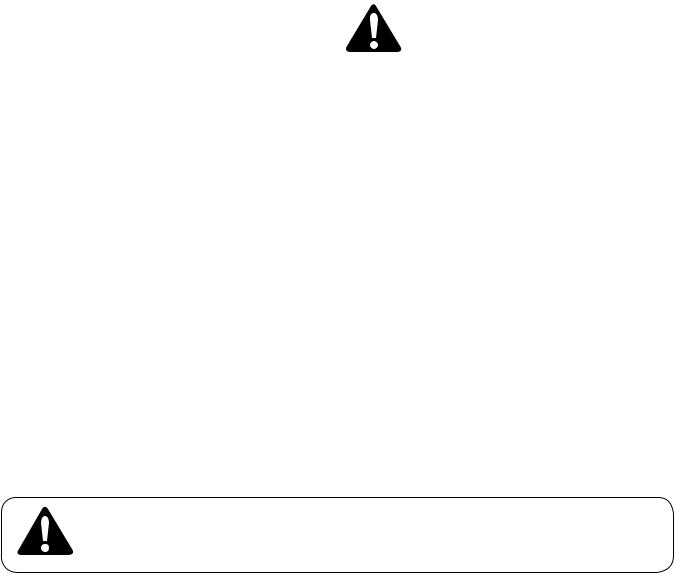
3.Periodically check to make sure the blades come to complete stop within approximately (5) five seconds after operating the blade disengagement control. If the blades do not stop within the this time frame, your machine should be serviced professionally by an authorized Cub Cadet Service Dealer.
4.Check brake operation frequently as it is subjected to wear during normal operation. Adjust and service as required.
5.Check the blade(s) and engine mounting bolts at frequent intervals for proper tightness. Also, visually inspect blade(s) for damage (e.g., excessive wear, bent, cracked). Replace the blade(s) with the original equipment manufacturer’s (O.E.M.) blade(s) only, listed in this manual. “Use of parts which do not meet the original equipment specifications may lead to improper performance and compromise safety!”
6.Mower blades are sharp. Wrap the blade or wear gloves, and use extra caution when servicing them.
7.Keep all nuts, bolts, and screws tight to be sure the equipment is in safe working condition.
8.Never tamper with the safety interlock system or other safety devices. Check their proper operation regularly.
9.After striking a foreign object, stop the engine, disconnect the spark plug wire(s) and ground against the engine. Thoroughly inspect the machine for any damage. Repair the damage before starting and operating.
10.Never attempt to make adjustments or repairs to the machine while the engine is running.
11.Grass catcher components and the discharge cover are subject to wear and damage which could expose moving parts or allow objects to be thrown. For safety protection, frequently check components and replace immediately with original equipment manufacturer’s (O.E.M.) parts only, listed in this manual. “Use of parts which do not meet the original equipment specifications may lead to improper performance and compromise safety!”
12.Do not change the engine governor settings or over-speed the engine. The governor controls the maximum safe operating speed of the engine.
13.Maintain or replace safety and instruction labels, as necessary.
14.Observe proper disposal laws and regulations for gas, oil, etc. to protect the environment.
15.According to the Consumer Products Safety Commission (CPSC) and the U.S. Environmental Protection Agency (EPA), this product has an Average Useful Life of seven (7) years,
or 390 hours of operation. At the end of the Average Useful Life have the machine inspected annually by an authorized service dealer to ensure that all mechanical and safety systems are working properly and not worn excessively. Failure to do so can result in accidents, injuries or death.
Do not modify engine
To avoid serious injury or death, do not modify engine in any way. Tampering with the governor setting can lead to a runaway engine and cause it to operate at unsafe speeds. Never tamper with factory setting of engine governor.
Notice Regarding Emissions
Engines which are certified to comply with California and federal
EPA emission regulations for SORE (Small Off Road Equipment) are certified to operate on regular unleaded gasoline, and may include the following emission control systems: Engine
Modification (EM), Oxidizing Catalyst (OC), Secondary Air
Injection (SAI) and Three Way Catalyst (TWC) if so equipped.
When required, models are equipped with low permeation fuel lines and fuel tanks for evaporative emission control. California models may also include a carbon canister. Please contact Customer Support for information regarding the evaporative emission control configuration for your model.
Spark Arrestor
WARNING! This machine is equipped with an internal combustion engine and should not be used on or near any unimproved forest-covered, brushcovered or grass-covered land unless the engine’s exhaust system is equipped with a spark arrestor meeting applicable local or state laws (if any).
If a spark arrestor is used, it should be maintained in effective working order by the operator. In the State of California the above is required by law (Section 4442 of the California Public
Resources Code). Other states may have similar laws. Federal laws apply on federal lands.
A spark arrestor for the muffler is available through your nearest engine authorized service dealer or contact the service department, P.O. Box 361131 Cleveland, Ohio 44136-0019.
WARNING! Your Responsibility—Restrict the use of this power machine to persons who read, understand and follow the warnings and instructions in this manual and on the machine.
SAVE THESE INSTRUCTIONS!
6 |
|
Section 2 — Important Safe Operation Practices |
|
||
|
|
|
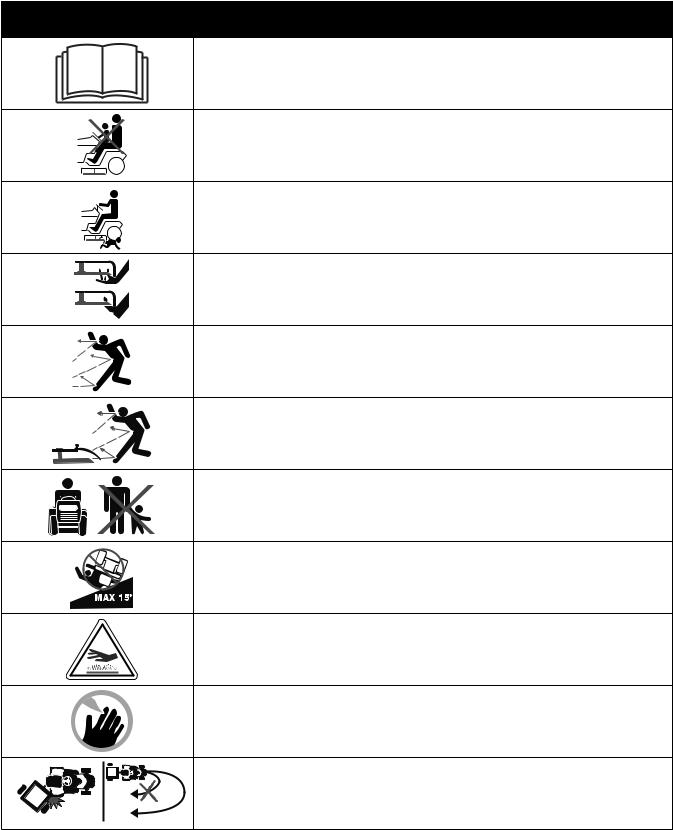
Safety Symbols
This page depicts and describes safety symbols that may appear on this product. Read, understand, and follow all instructions on the machine before attempting to assemble and operate.
Symbol |
Description |
READ THE OPERATOR’S MANUAL(S)
Read, understand, and follow all instructions in the manual(s) before attempting to assemble and operate
DANGER— ROTATING BLADES
Never carry passengers. Never carry children, even with the blades off.
DANGER— ROTATING BLADES
Always look down and behind before and while backing to avoid a back-over accident.
WARNING— ROTATING BLADES
Do not put hands or feet near rotating parts or under the cutting deck. Contact with the blade(s) can amputate hands and feet.
WARNING—THROWNOBJECTS
This machine may pick up and throw and objects which can cause serious personal injury.
WARNING—THROWNOBJECTS
This machine may pick up and throw and objects which can cause serious personal injury.
BYSTANDERS
Keep bystanders, helpers, children and pets at least 75 feet from the machine while it is in operation.
WARNING—SLOPEOPERATION
Do not operate this machine on a slope greater than 15 degrees.
WARNING— HOT SURFACE
Engine parts, especially the muffler, become extremely hot during operation. Allow engine and muffler to cool before touching.
DANGER — ROTATING BLADES
To reduce the risk of injury, keep hands and feet away. Do not operate unless discharge cover or grass catcher is in its proper place. If damaged, replace immediately.
WARNING—TOWING
Avoid jack-knifing when towing, go slow and make wide turns.
Section 2 — Important Safe Operation Practices |
|
7 |
|
||
|
|
|
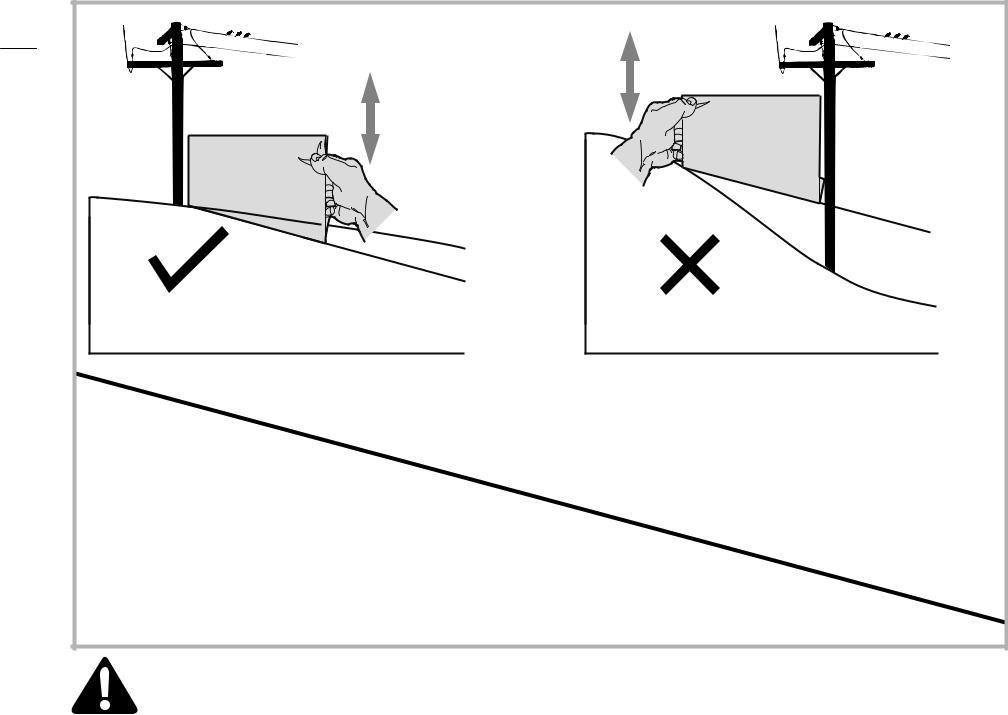
racticesP perationO afeS mportantI — 2 ectionS 8
Slope Gauge
15° Slope
(OK)
Slope |
(TOO STEEP) |
Figure 1 |
Figure 2 |
15°
dashed line
USE THIS SLOPE GAUGE TO DETERMINE
IF A SLOPE IS TOO STEEP FOR SAFE OPERATION!
To check the slope, proceed as follows:
1.Remove this page and fold along the dashed line.
2.Locate a vertical object on or behind the slope (e.g. a pole, building, fence, tree, etc.)
3.Align either side of the slope gauge with the object (See Figure 1 and Figure 2 ).
4.Adjust gauge up or down until the left corner touches the slope (See Figure 1 and Figure 2).
5.If there is a gap below the gauge, the slope is too steep for safe operation (See Figure 2 above).
WARNING! Slopes are a major factor related to tip-over and roll-over accidents which can result in severe injury or death.
Do not operate machine on slopes in excess of 15 degrees. All slopes require extra caution. If you cannot back up the slope or if you feel uneasy on it, do not mow it. Always mow up and down slopes, never across the face of slopes.
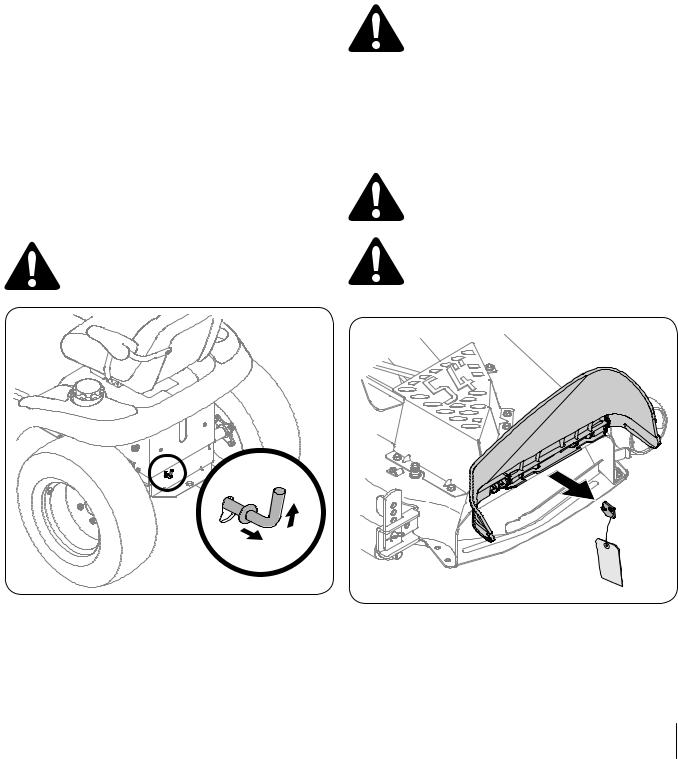
Assembly & Set-Up |
3 |
|
|
|
|
Contents of Crate |
|
• |
One Garden Tractor |
• |
One Oil Drain Tube |
• |
One Deck Wash Hose Coupler |
• |
One Garden Tractor Operator’s |
• |
One Engine Operator’s Manual |
• |
One Product Registration Card |
|
Manual |
|
|
|
|
Tractor Set-Up
Moving The Tractor Manually
Your tractor’s transmission is equipped with a hydrostatic relief valve for occasions when it is necessary to move the tractor manually. Opening this valve permits the fluid in the transmission to bypass its normal route, allowing the rear tires to “freewheel.” To open the hydrostatic relief valve, proceed as follows:
1.Locate the hydrostatic bypass rod in the rear of the tractor.
See Figure 3-1.
2.Pull the hydrostatic bypass rod outward, then up, to lock it in place.
NOTE: The transmission will NOT engage when the hydrostatic bypass rod is pulled out. Return the rod to its normal position prior to operating the tractor.
CAUTION: Never attempt to move the tractor manually without first opening the hydrostatic relief valve. Doing so will result in serious damage to the tractor’s transmission.
Shipping Brace Removal
WARNING! Make sure the garden tractor’s engine is off, set the parking brake and remove the ignition key before removing the shipping brace.
1.Locate the shipping brace, if present, and warning tag found on the right side of the cutting deck. See Figure 3-2.
2.While holding the discharge chute with your left hand, remove the shipping brace with your right hand by grasping it between your thumb and index finger and rotating it clockwise.
WARNING! The shipping brace is used for packaging purposes only. Remove and discard the shipping brace before operating your garden tractor.
WARNING! The mowing deck is capable of throwing objects. Failure to operate the riding mower without the discharge cover in the proper operating position could result in serious personal injury and/or property damage.
Figure 3-1
Figure 3-2
9
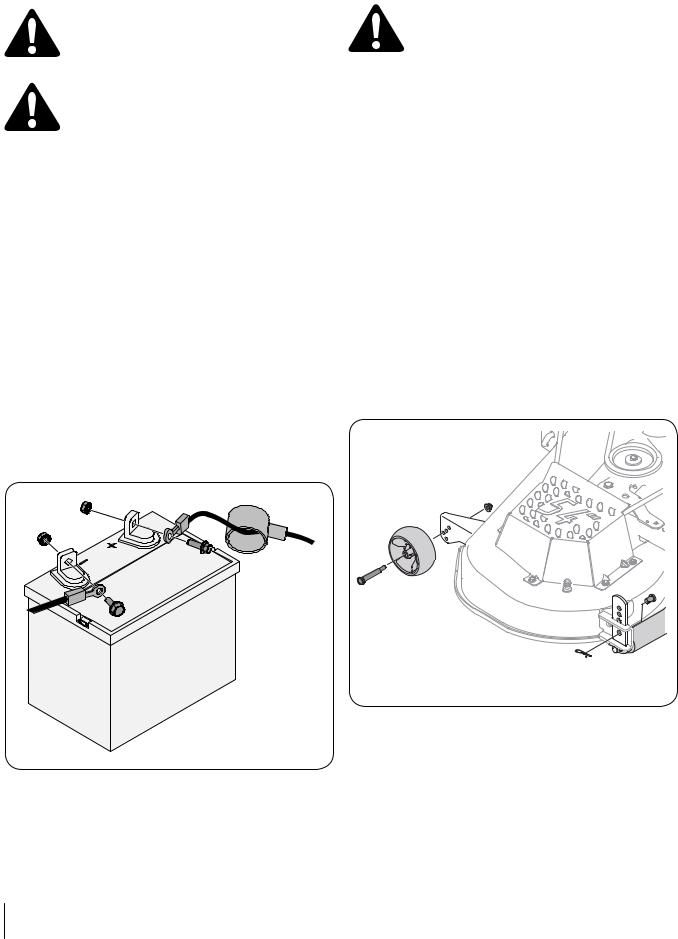
Connecting the Battery Cables
CALIFORNIA PROPOSITION 65 WARNING!
Battery posts, terminals, and related accessories contain lead and lead compounds, chemicals known to the State of California to cause cancer and reproductive harm. Wash hands after handling.
CAUTION: When attaching battery cables, always connect the POSITIVE (Red) wire to its terminal first,
followed by the NEGATIVE (Black) wire.
For shipping reasons, both battery cables on your equipment may have been left disconnected from the terminals at the factory. To connect the battery cables, proceed as follows:
NOTE: The positive battery terminal is marked Pos. (+). The negative battery terminal is marked Neg. (–).
NOTE: If the positive battery cable is already attached, skip ahead to step 2.
1.Remove the plastic cover, if present, from the positive battery terminal and attach the red cable to the positive battery terminal (+) with the bolt and hex nut. See Figure
3-3.
2.Remove the plastic cover, if present, from the negative battery terminal and attach the black cable to the negative battery terminal (–) with the bolt and hex nut. See Figure
3-3.
3.Position the red rubber boot over the positive battery terminal to help protect it from corrosion.
NOTE: If the battery is put into service after the date shown on top/side of battery, charge the battery as instructed in the
Maintenance section your Operator’s Manual prior to operating the tractor.
Figure 3-3
Checking Tire Pressure
WARNING! Never exceed the maximum inflation pressure shown on the sidewall of the tire. Do not overinflate tires. Check sidewall of tires for maximum psi. Equal tire pressure should be maintained at all times.
The tires on your tractor may be over inflated for shipping purposes. Reduce the tire pressure before operating the tractor. Check sidewall of tires for maximum psi.
Setting the Deck Gauge Wheels and Roller
Move the tractor on a firm and level surface, preferably pavement, and proceed as follows
1.Select the height position of the cutting deck by placing the deck lift lever in the normally desired mowing height setting (any of the six different cutting height notches on the right fender).
2.Check the gauge wheels for contact or excessive clearance with the surface below. The deck gauge wheels should have between ¼-inch and ½-inch clearance above the ground.
If the gauge wheels have excessive clearance or contact with the surface, adjust as follows:
a.Raise the deck lift handle to its highest setting.
b.Remove the front gauge wheels by removing the lock nuts and shoulder screws which secure them to the deck. See Figure 3-4.
Figure 3-4
c.Place the deck lift lever in the desired mowing height setting.
d.Reinsert the shoulder screw (with each gauge wheel) into the index hole that leaves approximately ½-inch between the bottom of the wheel and the pavement.
e.If equipped, remove the clevis pins and hairpin clips from the deck roller brackets on the left and right sides of the cutting deck. See Figure 3-4.
10 Section 2 — Assembly & Set-Up
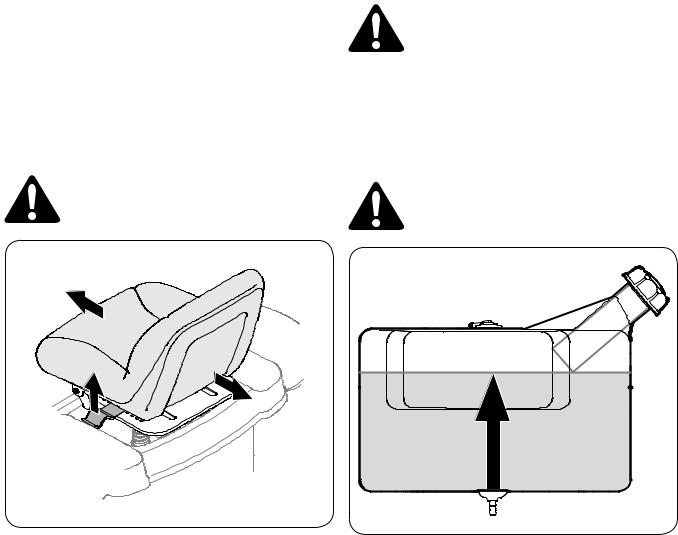
f.Position the deck roller brackets up or down through the slots on the rear of the deck until desired position is reached, then reattach with the clevis pins and hairpin clips just removed. Be certain that the left roller bracket and the right roller bracket are set in the same position.
Refer to Leveling the Deck in the Maintenance section of this manual for more detailed instructions regarding various deck adjustments.
Adjusting the Seat
To adjust the position of the seat, pull up and hold the seat adjustment lever. Slide the seat forward or rearward to the desired position; then release the adjustment lever. Make sure seat is locked into position before operating the tractor. See
Figure 3-5.
WARNING! Before operating the tractor, make sure the seat is engaged in the seat-stop. Engage the parking brake. Stand behind the machine and pull back on seat until it clicks into place.
Figure 3-5
Gas and Oil
The fuel tank is located under the hood. Remove the fuel cap by turning it counterclockwise. Use only clean, fresh (no more than
30 days old), unleaded gasoline. Do not overfill the tank.
WARNING! Use extreme care when handling gasoline. Gasoline is extremely flammable and the vapors are explosive. Never fuel the machine indoors or while the engine is hot or running. Extinguish cigarettes, cigars, pipes and all other sources of ignition.
IMPORTANT: Be sure to STOP filling tank once fuel is seen inside the filler neck. This ensures that a proper expansion volume is created. Do NOT top off the tank. See Figure 3-6.
NOTE: Your tractor is shipped with oil in the engine. However, you MUST check the oil level before operating.
CAUTION: Always check the engine oil level before each use as instructed in the Engine Owner’s
Manual. Add oil as necessary. Failure to do so may result in serious damage to your engine.
Figure 3-6
Section 2 — Assembly & Set-Up |
|
11 |
|
||
|
|
|
